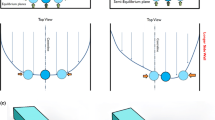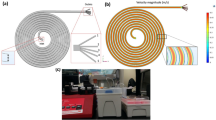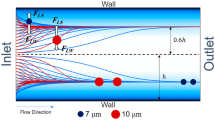Abstract
Microfluidic-based sorting systems are an integral part of many biological applications, where sorting of cells, microorganisms, and particles is of interest. In this paper, a computational fluid dynamics model is established to expand investigations on a hybrid microparticle sorting method, which combines inertia-magnetic focusing and hydrodynamic separation, known as multiplex inertia-magnetic fractionation (MIMF). This microfluidic device consists of two regions, i.e. a narrow microchannel with a magnet on its side for inertial and magnetophoretic focusing of particles and a downstream wide hydrodynamic expansion zone for particles’ separation and imaging. A Lagrangian–Eulerian framework was adopted to simulate particle trajectories using the ANSYS-Fluent discrete phase modeling (DPM) approach. Acting forces that were considered to predict particle trajectories included the drag, inertial lift, Saffman lift, gravitational, and magnetophoretic forces. User-defined functions were used for inertial lift and magnetophoretic forces that are not built-in relations in the ANSYS-Fluent DPM. Numerical results were verified and validated against the experimental data for MIMF of 5 and 11 µm magnetic particles at flow rates of 0.5–5 mL/h. Particles fractionation throughput and purity in the expansion region could be predicted with errors of 6% and 2%, respectfully. The validated model was then used to perform a numerical parametric study on the unknown effects of magnetization, particle size, higher flow rates, and fluid viscosity on MIMF. The presented numerical approach can be used as a tool for future experimental design of inertia-magnetophoretic microfluidic particle sorting devices.












Similar content being viewed by others
References
Adams JD, Kim U, Soh HT (2008) Multitarget magnetic activated cell sorter. Proc Natl Acad Sci USA 105:18165–18170. https://doi.org/10.1073/pnas.0809795105
Amin A (2014) High throughput particle separation using differential fermat spiral microchannel with variable channel width. University of Akron, Akron
Andersson H, Van den Berg A (2003) Microfluidic devices for cellomics: a review Sensors and actuators B. Chemical 92:315–325
ANSYS I (2018) ANSYS Fluent Theory Guide 19.0
Applegate RW Jr et al (2006) Microfluidic sorting system based on optical waveguide integration and diode laser bar trapping. Lab Chip 6:422–426
Baker CA, Duong CT, Grimley A, Roper MG (2009) Recent advances in microfluidic detection systems. Bioanalysis 1:967–975
Bayat P, Rezai P (2018) Microfluidic curved-channel centrifuge for solution exchange of target microparticles and their simultaneous separation from bacteria. Soft Matter 14:5356–5363
Bélanger MC, Marois Y (2001) Hemocompatibility, biocompatibility, inflammatory and in vivo studies of primary reference materials low-density polyethylene and polydimethylsiloxane: a review. J Biomed Mater Res 58:467–477
Bhagat AAS, Kuntaegowdanahalli SS, Papautsky I (2008) Continuous particle separation in spiral microchannels using dean flows and differential migration. Lab Chip 8:1906–1914
Chalmers JJ, Zborowski M, Sun L, Moore L (1998) Flow through, immunomagnetic cell separation. Biotechnol Progress 14:141–148
Chen J, Li J, Sun Y (2012) Microfluidic approaches for cancer cell detection, characterization, and separation. Lab Chip 12:1753–1767
Cheng C, Yang L, Zhong M, Deng W, Tan Y, Xie Q, Yao S (2018) Au nanocluster-embedded chitosan nanocapsules as labels for the ultrasensitive fluorescence immunoassay of Escherichia coli O157:H7. Analyst 143:4067–4073. https://doi.org/10.1039/c8an00987b
Dalili A, Samiei E, Hoorfar M (2019) A review of sorting, separation and isolation of cells and microbeads for biomedical applications: microfluidic approaches. Analyst 144:87–113. https://doi.org/10.1039/c8an01061g
Di Carlo D (2009) Inertial microfluidics. Lab Chip 9:3038–3046
Di Carlo D, Irimia D, Tompkins RG, Toner M (2007) Continuous inertial focusing, ordering, and separation of particles in microchannels. Proc Natl Acad Sci 104:18892–18897
Eyal S, Quake SR (2002) Velocity-independent microfluidic flow cytometry. Electrophoresis 23:2653–2657
Feng J, Hu HH, Joseph DD (1994a) Direct simulation of initial value problems for the motion of solid bodies in a Newtonian fluid Part 1. Sedimentation. J Fluid Mech 261:95–134
Feng J, Hu HH, Joseph DD (1994b) Direct simulation of initial value problems for the motion of solid bodies in a Newtonian fluid. Part 2. Couette and Poiseuille flows. J Fluid Mech 277:271–301
Forbes TP, Forry SP (2012) Microfluidic magnetophoretic separations of immunomagnetically labeled rare mammalian cells. Lab Chip 12:1471–1479
Geens M, Van de Velde H, De Block G, Goossens E, Van Steirteghem A, Tournaye H (2006) The efficiency of magnetic-activated cell sorting and fluorescence-activated cell sorting in the decontamination of testicular cell suspensions in cancer patients. Hum Reprod 22:733–742
Hale C, Darabi J (2014) Magnetophoretic-based microfluidic device for DNA isolation. Biomicrofluidics 8:044118
Hejazian M, Li W, Nguyen N-T (2015) Lab on a chip for continuous-flow magnetic cell separation. Lab Chip 15:959–970
Ho B, Leal L (1974) Inertial migration of rigid spheres in two-dimensional unidirectional flows. J Fluid Mech 65:365–400
Ho B, Leal L (1976) Migration of rigid spheres in a two-dimensional unidirectional shear flow of a second-order fluid. J Fluid Mech 76:783–799
Hoffmann C, Franzreb M, Holl W (2002) A novel high-gradient magnetic separator (HGMS) design for biotech applications. IEEE Trans Appl Supercond 12:963–966
Huang LR, Cox EC, Austin RH, Sturm JC (2004) Continuous particle separation through deterministic lateral displacement. Science 304:987–990
Jiang Y, Zou S, Cao X (2016) Rapid and ultra-sensitive detection of foodborne pathogens by using miniaturized microfluidic devices: a review. Anal Methods 8:6668–6681. https://doi.org/10.1039/C6AY01512C
Julius M, Masuda T, Herzenberg L (1972) Demonstration that antigen-binding cells are precursors of antibody-producing cells after purification with a fluorescence-activated cell sorter. Proc Natl Acad Sci 69:1934–1938
Karabacak NM et al (2014) Microfluidic, marker-free isolation of circulating tumor cells from blood samples. Nat Protoc 9:694
Kim MJ, Lee DJ, Youn JR, Song YS (2016) Two step label free particle separation in a microfluidic system using elasto-inertial focusing and magnetophoresis. RSC Adv 6:32090–32097. https://doi.org/10.1039/C6RA03146C
Krishnan JN, Kim C, Park HJ, Kang JY, Kim TS, Kim SK (2009) Rapid microfluidic separation of magnetic beads through dielectrophoresis and magnetophoresis. Electrophoresis 30:1457–1463
Kumar V, Rezai P (2017a) Magneto-Hydrodynamic Fractionation (MHF) for continuous and sheathless sorting of high-concentration paramagnetic microparticles. Biomed Microdevices 19:39
Kumar V, Rezai P (2017b) Multiplex Inertio-Magnetic Fractionation (MIMF) of magnetic and non-magnetic microparticles in a microfluidic device. Microfluid Nanofluid 21:83
Lee MG, Shin JH, Bae CY, Choi S, Park J-K (2013) Label-free cancer cell separation from human whole blood using inertial microfluidics at low shear stress. Anal Chem 85:6213–6218
Li A, Ahmadi G (1992) Dispersion and deposition of spherical particles from point sources in a turbulent channel flow. Aerosol Sci Technol 16:209–226
Li P et al (2015) Acoustic separation of circulating tumor cells. Proc Natl Acad Sci 112:4970–4975
Lu X, Liu C, Hu G, Xuan X (2017) Particle manipulations in non-Newtonian microfluidics: a review. J Colloid Interface Sci 500:182–201
Mach AJ, Di Carlo D (2010) Continuous scalable blood filtration device using inertial microfluidics. Biotechnol Bioeng 107:302–311
Martel JM, Toner M (2014) Inertial focusing in microfluidics. Annu Rev Biomed Eng 16:371–396
Matas J-P, Morris JF, Guazzelli É (2004) Inertial migration of rigid spherical particles in Poiseuille flow. J Fluid Mech 515:171–195
Modak N, Datta A, Ganguly R (2009) Cell separation in a microfluidic channel using magnetic microspheres. Microfluid Nanofluid 6:647
Modak N, Kejriwal D, Nandy K, Datta A, Ganguly R (2010) Experimental and numerical characterization of magnetophoretic separation for MEMS-based biosensor applications. Biomed Microdevice 12:23–34
Mohamed H, Turner JN, Caggana M (2007) Biochip for separating fetal cells from maternal circulation. J Chromatogr A 1162:187–192
Nagrath S et al (2007) Isolation of rare circulating tumour cells in cancer patients by microchip technology. Nature 450:1235
Nam J, Lim H, Kim D, Jung H, Shin S (2012) Continuous separation of microparticles in a microfluidic channel via the elasto-inertial effect of non-Newtonian fluid. Lab Chip 12:1347–1354
Nam J, Namgung B, Lim CT, Bae J-E, Leo HL, Cho KS, Kim S (2015) Microfluidic device for sheathless particle focusing and separation using a viscoelastic fluid. J Chromatogr A 1406:244–250
Nandy K, Chaudhuri S, Ganguly R, Puri IK (2008) Analytical model for the magnetophoretic capture of magnetic microspheres in microfluidic devices. J Magn Magn Mater 320:1398–1405
Ng AH, Uddayasankar U, Wheeler AR (2010) Immunoassays in microfluidic systems. Anal Bioanal Chem 397:991–1007
Ounis H, Ahmadi G, McLaughlin JB (1991) Brownian diffusion of submicrometer particles in the viscous sublayer. J Colloid Interface Sci 143:266–277
Ozkumur E et al (2013) Inertial focusing for tumor antigen–dependent and–independent sorting of rare circulating tumor cells. Sci Transl Med 5:179ra147
Pappas D (2016) Microfluidics and cancer analysis: cell separation, cell/tissue culture, cell mechanics, and integrated analysis systems. Analyst 141:525–535. https://doi.org/10.1039/c5an01778e
Parrott C (2017) Computational fluid dynamics (CFD) simulation of microfluidic focusing in a low-cost flow cytometer. Oregon State University, Oregon
Podar M et al (2007) Targeted access to the genomes of low-abundance organisms in complex microbial communities. Appl Environ Microbiol 73:3205–3214
Ramadan Q, Christophe L, Teo W, ShuJun L, Hua FH (2010) Flow-through immunomagnetic separation system for waterborne pathogen isolation and detection: application to Giardia and Cryptosporidium cell isolation. Anal Chim Acta 673:101–108
Richardson SD, Ternes TA (2011) Water analysis: emerging contaminants and current issues. Anal Chem 83:4614–4648
Sabaghan A, Edalatpour M, Moghadam MC, Roohi E, Niazmand H (2016) Nanofluid flow and heat transfer in a microchannel with longitudinal vortex generators: two-phase numerical simulation. Appl Therm Eng 100:179–189
Saeed OO, Li R, Deng Y (2014) Microfluidic approaches for cancer cell separation. J Biomed Sci Eng 7:1005
Saffman P (1965) The lift on a small sphere in a slow shear flow. J Fluid Mech 22:385–400
Sajeesh P, Sen AK (2014) Particle separation and sorting in microfluidic devices: a review. Microfluid Nanofluid 17:1–52. https://doi.org/10.1007/s10404-013-1291-9
Saliba A-E et al (2010) Microfluidic sorting and multimodal typing of cancer cells in self-assembled magnetic arrays. Proc Natl Acad Sci 107:14524–14529
Shardt O, Mitra SK, Derksen J (2012) Lattice Boltzmann simulations of pinched flow fractionation. Chem Eng Sci 75:106–119
Telleman P, Larsen UD, Philip J, Blankenstein G, Wolff A (1998) Cell sorting in microfluidic systems. In: Micro total analysis systems’ 98. Springer, pp 39–44
Valero A, Braschler T, Demierre N, Renaud P (2010) A miniaturized continuous dielectrophoretic cell sorter and its applications. Biomicrofluidics 4:022807
Wang MM et al (2005) Microfluidic sorting of mammalian cells by optical force switching. Nat Biotechnol 23:83
Wyatt Shields Iv C, Reyes CD, López GP (2015) Microfluidic cell sorting: a review of the advances in the separation of cells from debulking to rare cell isolation. Lab Chip 15:1230–1249. https://doi.org/10.1039/c4lc01246a
Yamada M, Seki M (2005) Hydrodynamic filtration for on-chip particle concentration and classification utilizing microfluidics. Lab Chip 5:1233–1239
Yamada M, Nakashima M, Seki M (2004) Pinched flow fractionation: continuous size separation of particles utilizing a laminar flow profile in a pinched microchannel. Anal Chem 76:5465–5471
Yang BH, Wang J, Joseph DD, Hu HH, Pan T-W, Glowinski R (2005) Migration of a sphere in tube flow. J Fluid Mech 540:109–131
Yang R-J, Hou H-H, Wang Y-N, Fu L-M (2016) Micro-magnetofluidics in microfluidic systems: a review. Sens Actuators B Chem 224:1–15
Yilmaz S, Singh AK (2012) Single cell genome sequencing. Curr Opin Biotechnol 23:437–443
Zhang J, Yan S, Yuan D, Zhao Q, Tan SH, Nguyen N-T, Li W (2016) A novel viscoelastic-based ferrofluid for continuous sheathless microfluidic separation of nonmagnetic microparticles. Lab Chip 16:3947–3956
Zhang J et al (2018) Tunable particle separation in a hybrid dielectrophoresis (DEP)-inertial microfluidic device. Sens Actuators B Chem 267:14–25
Zhou J, Papautsky I (2013) Fundamentals of inertial focusing in microchannels. Lab Chip 13:1121–1132
Zhou Y, Ma Z, Tayebi M, Ai Y (2019) Submicron particle focusing and exosome sorting by wavy microchannel structures within viscoelastic fluids. Anal Chem 91:4577–4584
Zhu T, Lichlyter DJ, Haidekker MA, Mao L (2011) Analytical model of microfluidic transport of non-magnetic particles in ferrofluids under the influence of a permanent magnet. Microfluid Nanofluid 10:1233–1245
Zolgharni M, Azimi S, Bahmanyar M, Balachandran W (2007) A numerical design study of chaotic mixing of magnetic particles in a microfluidic bio-separator. Microfluid Nanofluid 3:677–687
Acknowledgements
This research has received funding support from Kuwait Foundation for the Advancement of Sciences under project code: PN18-15EC-04 (PR, AE) and Ontario Ministry of Agriculture, Food and Rural Affairs (PR). Such support does not indicate endorsement by Kuwait Foundation for the Advancement of Sciences or the Government of Ontario of the contents of this material.
Author information
Authors and Affiliations
Corresponding author
Ethics declarations
Conflict of interest
There are no conflicts to declare.
Additional information
Publisher's Note
Springer Nature remains neutral with regard to jurisdictional claims in published maps and institutional affiliations.
Electronic supplementary material
Below is the link to the electronic supplementary material.
Rights and permissions
About this article
Cite this article
Charjouei Moghadam, M., Eilaghi, A. & Rezai, P. Inertia-magnetic particle sorting in microfluidic devices: a numerical parametric investigation. Microfluid Nanofluid 23, 135 (2019). https://doi.org/10.1007/s10404-019-2301-3
Received:
Accepted:
Published:
DOI: https://doi.org/10.1007/s10404-019-2301-3




